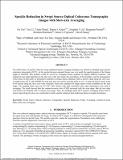| dc.contributor.author | Tan, Ou | |
| dc.contributor.author | Li, Yan | |
| dc.contributor.author | Wang, Yimin | |
| dc.contributor.author | Kraus, Martin F. | |
| dc.contributor.author | Liu, Jonathan Jaoshin | |
| dc.contributor.author | Baumann, Bernhard | |
| dc.contributor.author | Fujimoto, James G. | |
| dc.contributor.author | Huang, David | |
| dc.contributor.author | Potsaid, Benjamin M. | |
| dc.date.accessioned | 2015-12-13T19:55:52Z | |
| dc.date.available | 2015-12-13T19:55:52Z | |
| dc.date.issued | 2012-02 | |
| dc.identifier.issn | 0277-786X | |
| dc.identifier.issn | 1605-7422 | |
| dc.identifier.uri | http://hdl.handle.net/1721.1/100218 | |
| dc.description.abstract | The effectiveness of speckle reduction using traditional frame averaging technique was limited in ultrahigh speed optical coherence tomography (OCT). As the motion between repeated frames was very small, the speckle pattern of the frames might be identical. This problem could be solved by averaging frames acquired at slightly different locations. The optimized scan range depended on the spot size of the laser beam, the smoothness of the boundary, and the homogeneity of the tissue. In this study we presented a method to average frames obtained within a narrow range along the slow-axis. A swept-source OCT with 100,000 Hz axial scan rate was used to scan the retina in vivo. A series of narrow raster scans (0-50 micron along the slow axis) were evaluated. Each scan contained 20 image frames evenly distributed in the scan range. The imaging frame rate was 417 HZ. Only frames with high correlation after rigid registration were used in averaging. The result showed that the contrast-to-noise ratio (CNR) increased with the scan range. But the best edge reservation was obtained with 15 micron scan range. Thus, for ultrahigh speed OCT systems, averaging frames from a narrow band along the slow-axis could achieve better speckle reduction than traditional frame averaging techniques. | en_US |
| dc.language.iso | en_US | |
| dc.publisher | SPIE | en_US |
| dc.relation.isversionof | http://dx.doi.org/10.1117/12.911735 | en_US |
| dc.rights | Article is made available in accordance with the publisher's policy and may be subject to US copyright law. Please refer to the publisher's site for terms of use. | en_US |
| dc.source | SPIE | en_US |
| dc.title | Speckle reduction in swept source optical coherence tomography images with slow-axis averaging | en_US |
| dc.type | Article | en_US |
| dc.identifier.citation | Tan, Ou, Yan Li, Yimin Wang, Martin F. Kraus, Jonathan J. Liu, Benjamin Potsaid, Bernhard Baumann, James G. Fujimoto, and David Huang. “Speckle Reduction in Swept Source Optical Coherence Tomography Images with Slow-Axis Averaging.” Edited by Joseph A. Izatt, James G. Fujimoto, and Valery V. Tuchin. Optical Coherence Tomography and Coherence Domain Optical Methods in Biomedicine XVI (January 30, 2012). © 2012 Society of Photo-Optical Instrumentation Engineers (SPIE). | en_US |
| dc.contributor.department | Massachusetts Institute of Technology. Department of Electrical Engineering and Computer Science | en_US |
| dc.contributor.department | Massachusetts Institute of Technology. Research Laboratory of Electronics | en_US |
| dc.contributor.mitauthor | Kraus, Martin F. | en_US |
| dc.contributor.mitauthor | Liu, Jonathan Jaoshin | en_US |
| dc.contributor.mitauthor | Potsaid, Benjamin M. | en_US |
| dc.contributor.mitauthor | Baumann, Bernhard | en_US |
| dc.contributor.mitauthor | Fujimoto, James G. | en_US |
| dc.relation.journal | Proceedings of SPIE--the International Society for Optical Engineering | en_US |
| dc.eprint.version | Final published version | en_US |
| dc.type.uri | http://purl.org/eprint/type/ConferencePaper | en_US |
| eprint.status | http://purl.org/eprint/status/NonPeerReviewed | en_US |
| dspace.orderedauthors | Tan, Ou; Li, Yan; Wang, Yimin; Kraus, Martin F.; Liu, Jonathan J.; Potsaid, Benjamin; Baumann, Bernhard; Fujimoto, James G.; Huang, David | en_US |
| dc.identifier.orcid | https://orcid.org/0000-0002-0828-4357 | |
| dspace.mitauthor.error | true | |
| mit.license | PUBLISHER_POLICY | en_US |
| mit.metadata.status | Complete | |
